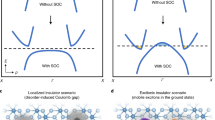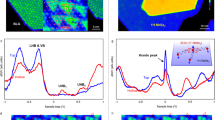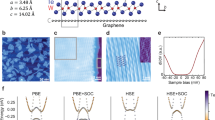Abstract
Monolayer semiconducting transition-metal dichalcogenides (TMDs) represent a unique class of two-dimensional (2D) electron systems. Their atomically thin structure facilitates gate tunability just like graphene does, but unlike graphene, TMDs have the advantage of a sizable band gap and strong spin–orbit coupling. Measurements under large magnetic fields have revealed an unusual Landau level (LL) structure1,2,3, distinct from other 2D electron systems. However, owing to the limited sample quality and poor electrical contact, probing the lowest LLs has been challenging, and observation of electron correlations within the fractionally filled LL regime has not been possible. Here, through bulk electronic compressibility measurements, we investigate the LL structure of monolayer WSe2 in the extreme quantum limit, and observe fractional quantum Hall states in the lowest three LLs. The odd-denominator fractional quantum Hall sequences demonstrate a systematic evolution with the LL orbital index, consistent with generic theoretical expectations. In addition, we observe an even-denominator state in the second LL that is expected to host non-Abelian statistics. Our results suggest that the 2D semiconductors can provide an experimental platform that closely resembles idealized theoretical models in the quantum Hall regime.
This is a preview of subscription content, access via your institution
Access options
Access Nature and 54 other Nature Portfolio journals
Get Nature+, our best-value online-access subscription
$29.99 / 30 days
cancel any time
Subscribe to this journal
Receive 12 print issues and online access
$259.00 per year
only $21.58 per issue
Buy this article
- Purchase on Springer Link
- Instant access to full article PDF
Prices may be subject to local taxes which are calculated during checkout



Similar content being viewed by others
Data availability
The data that support the plots within this paper and other findings of this study are available at https://doi.org/10.5518/807.
References
Wang, Z., Shan, J. & Mak, K. F. Valley- and spin-polarized Landau levels in monolayer WSe2. Nat. Nanotechnol. 12, 144–149 (2016).
Movva, H. C. P. et al. Density-dependent quantum Hall states and Zeeman splitting in monolayer and bilayer WSe2. Phys. Rev. Lett. 118, 247701 (2017).
Gustafsson, M. V. et al. Ambipolar Landau levels and strong band-selective carrier interactions in monolayer WSe2. Nat. Mater. 17, 411–415 (2018).
Tsui, D. C., Stormer, H. L. & Gossard, A. C. Two-dimensional magnetotransport in the extreme quantum limit. Phys. Rev. Lett. 48, 1559 (1982).
Kleinbaum, E., Kumar, A., Pfeiffer, L. N., West, K. W. & Csáthy, G. A. Gap reversal at filling factors 3 + 1/3 and 3 + 1/5: towards novel topological order in the fractional quantum hall regime. Phys. Rev. Lett. 114, 076801 (2015).
Willett, R. et al. Observation of an even-denominator quantum number in the fractional quantum Hall effect. Phys. Rev. Lett. 59, 1776–1779 (1987).
Falson, J. et al. Even-denominator fractional quantum Hall physics in ZnO. Nat. Phys. 11, 347–351 (2015).
Ki, D.-K., Fal’ko, V. I., Abanin, D. A. & Morpurgo, A. F. Observation of even denominator fractional quantum Hall effect in suspended bilayer graphene. Nano Lett. 14, 2135–2139 (2014).
Zibrov, A. A. et al. Tunable interacting composite fermion phases in a half-filled bilayer-graphene Landau level. Nature 549, 360–364 (2017).
Li, J. I. A. et al. Even-denominator fractional quantum Hall states in bilayer graphene. Science 358, 648–652 (2017).
Moore, G. & Read, N. Nonabelions in the fractional quantum Hall effect. Nuc. Phys. B 360, 362–396 (1991).
Levin, M., Halperin, B. I. & Rosenow, B. Particle-hole symmetry and the Pfaffian state. Phys. Rev. Lett. 99, 236806 (2007).
Lee, S.-S., Ryu, S., Nayak, C. & Fisher, M. P. A. Particle-hole symmetry and the \(\nu =\frac{5}{2}\)quantum Hall state. Phys. Rev. Lett. 99, 236807 (2007).
Son, D. T. Is the composite fermion a dirac particle? Phys. Rev. X 5, 031027 (2015).
Goerbig, M. O. Electronic properties of graphene in a strong magnetic field. Rev. Mod. Phys. 83, 1193–1243 (2011).
Dean, C. R. et al. Multicomponent fractional quantum Hall effect in graphene. Nat. Phys. 7, 693–696 (2011).
Feldman, B. E., Krauss, B., Smet, J. H. & Yacoby, A. Unconventional sequence of fractional quantum Hall states in suspended graphene. Science 337, 1196–1199 (2012).
Zibrov, A. et al. Even-denominator fractional quantum Hall states at an isospin transition in monolayer graphene. Nat. Phys. 14, 930–935 (2018).
de C. Chamon, C., Freed, D. E., Kivelson, S. A., Sondhi, S. L. & Wen, X. G. Two point-contact interferometer for quantum Hall systems. Phys. Rev. B 55, 2331–2343 (1997).
Xiao, D., Liu, G.-B., Feng, W., Xu, X. & Yao, W. Coupled spin and valley physics in monolayers of MoS2 and other group-VI dichalcogenides. Phys. Rev. Lett. 108, 196802 (2012).
Li, X., Zhang, F. & Niu, Q. Unconventional quantum Hall effect and tunable spin Hall effect in Dirac materials: application to an isolated MoS2 trilayer. Phys. Rev. Lett. 110, 066803 (2013).
Rose, F., Goerbig, M. O. & Piéchon, F. Spin- and valley-dependent magneto-optical properties of MoS2. Phys. Rev. B 88, 125438 (2013).
Larentis, S. et al. Large effective mass and interaction-enhanced Zeeman splitting of K-valley electrons in MoSe2. Phys. Rev. B 97, 201407 (2018).
Pisoni, R. et al. Interactions and magnetotransport through spin-valley coupled Landau levels in monolayer MoS2. Phys. Rev. Lett. 121, 247701 (2018).
Edelberg, D. et al. Approaching the intrinsic limit in transition metal diselenides via point defect control. Nano Lett. 19, 4371–4379 (2019).
Eisenstein, J. P., Pfeiffer, L. N. & West, K. W. Compressibility of the two-dimensional electron gas: measurements of the zero-field exchange energy and fractional quantum Hall gap. Phys. Rev. B 50, 1760–1778 (1994).
Jain, J. K. Composite Fermions (Cambridge University Press, 2007).
Goerbig, M. O. & Smith, C. M. Scaling approach to the phase diagram of quantum Hall systems. Europhys. Lett. 63, 736–742 (2003).
Goerbig, M. O., Lederer, P. & Smith, C. M. Competition between quantum-liquid and electron-solid phases in intermediate Landau levels. Phys. Rev. B 69, 115327 (2004).
Halperin, B. I. Theory of the quantized Hall conductance. Helv. Phys. Acta 56, 75–102 (1983).
Pan, W. et al. Exact quantization of the even-denominator fractional quantum Hall state at v=5/2 Landau level filling factor. Phys. Rev. Lett. 83, 3530–3533 (1999).
Pistunova, K. et al. Transport and photoluminescent characterization of high-quality single layer WSe2 devices. In APS March Meeting 2019 A15.007 (APS, 2019).
Apalkov, V. M. & Chakraborty, T. Stable Pfaffian state in bilayer graphene. Phys. Rev. Lett. 107, 186803 (2011).
Papić, Z., Abanin, D. A., Barlas, Y. & Bhatt, R. N. Tunable interactions and phase transitions in Dirac materials in a magnetic field. Phys. Rev. B 84, 241306 (2011).
Gervais, G. et al. Competition between a fractional quantum Hall liquid and bubble and Wigner crystal phases in the third Landau level. Phys. Rev. Lett. 93, 266804 (2004).
Zeng, Y. et al. High-quality magnetotransport in graphene using the edge-free Corbino geometry. Phys. Rev. Lett. 122, 137701 (2019).
Peterson, M. R., Jolicoeur, T. & das Sarma, S. Orbital Landau level dependence of the fractional quantum Hall effect in quasi-two-dimensional electron layers: finite-thickness effects. Phys. Rev. B 78, 155308 (2008).
Sreejith, G. J., Zhang, Y. & Jain, J. K. Surprising robustness of particle-hole symmetry for composite-fermion liquids. Phys. Rev. B 96, 125149 (2017).
Acknowledgements
We thank M. Goerbig, A. Kormanyos and F. Zhang for discussion, and W. Coniglio and B. Pullum for help with experiments. This research is primarily supported by the US Department of Energy (DE-SC0016703). Synthesis of WSe2 (D.R. and B.K.) was supported by the Center for Precision Assembly of Superstratic and Superatomic Solids, a Materials Science and Engineering Research Center (MRSEC), through NSF grant DMR-1420634. A portion of this work was performed at the National High Magnetic Field Laboratory, which is supported by National Science Foundation Cooperative Agreement no. DMR-1157490 and the state of Florida. Z.P. acknowledges support by EPSRC grant EP/R020612/1. K.W. and T.T. acknowledge support from the Elemental Strategy Initiative conducted by the MEXT, Japan and the CREST (JPMJCR15F3), JST.
Author information
Authors and Affiliations
Contributions
Q.S. fabricated the device with the help of E.S.; M.V.G. contributed to the development of the measurement set-up. Q.S. performed the measurements and analysed the data. Z.P. performed the numerical calculations. D.A.R. and B.K. grew the WSe2 crystals. K.W. and T.T. grew the hBN crystals. J.H. and C.R.D. advised on the experiments. The manuscript was written with input from all authors.
Corresponding author
Ethics declarations
Competing interests
The authors declare no competing interests.
Additional information
Peer review information Nature Nanotechnology thanks Jinfeng Jia and the other, anonymous, reviewers for their contribution to the peer review of this work.
Publisher’s note Springer Nature remains neutral with regard to jurisdictional claims in published maps and institutional affiliations.
Supplementary information
Supplementary Information
Supplementary discussion, Figs. 1–10 and refs. 1–49.
Rights and permissions
About this article
Cite this article
Shi, Q., Shih, EM., Gustafsson, M.V. et al. Odd- and even-denominator fractional quantum Hall states in monolayer WSe2. Nat. Nanotechnol. 15, 569–573 (2020). https://doi.org/10.1038/s41565-020-0685-6
Received:
Accepted:
Published:
Issue Date:
DOI: https://doi.org/10.1038/s41565-020-0685-6
This article is cited by
-
Evidence of the fractional quantum spin Hall effect in moiré MoTe2
Nature (2024)
-
Tunable spin and valley excitations of correlated insulators in Γ-valley moiré bands
Nature Materials (2023)
-
Strong correlations in two-dimensional transition metal dichalcogenides
Science China Physics, Mechanics & Astronomy (2023)
-
Bilayer WSe2 as a natural platform for interlayer exciton condensates in the strong coupling limit
Nature Nanotechnology (2022)
-
Low-resistance metal contacts to encapsulated semiconductor monolayers with long transfer length
Nature Electronics (2022)



